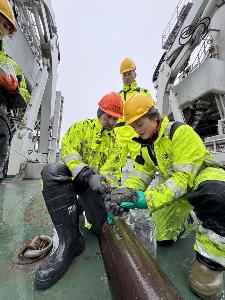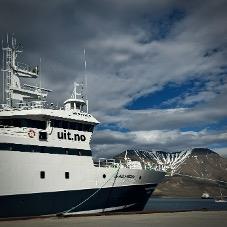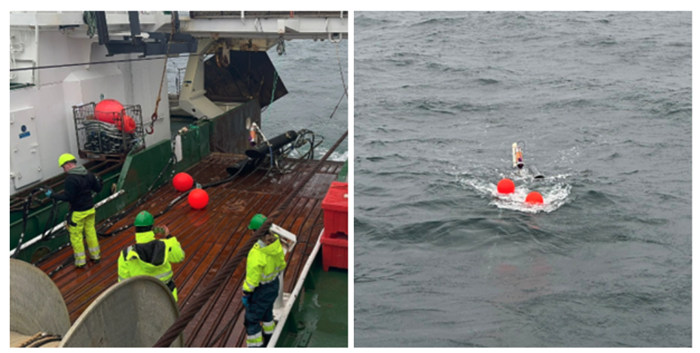“Would you like to join an offshore scientific expedition in the Arctic this April?” was the question that sparked Dr Yan Yu Ting and Miss Toh Yun Fann’s affinity with Norway.
Yu Ting, a Research Fellow at the Earth Observatory of Singapore, and Yun Fann, a PhD student at the Asian School of the Environment, were eager to gain new knowledge on past sea-level changes and skills that they could apply to their own research in Singapore. They joined their first expedition together in 2023, then both returned to Norway on separate expeditions in 2024.
 (Left) Yun Fann working on water quality data. (Right) Yu Ting subsampling sediments from a blade corer. (Source: Toh Yun Fann and Yan Yu Ting/Earth Observatory of Singapore)
(Left) Yun Fann working on water quality data. (Right) Yu Ting subsampling sediments from a blade corer. (Source: Toh Yun Fann and Yan Yu Ting/Earth Observatory of Singapore)
The AKMA3 Expedition, 2023
“We are both interested in using sedimentary and bathymetry to enhance our skillset for our own projects in Singapore, so we were excited to be invited to join the ‘Advancing Knowledge of Methane in the Arctic’ (AKMA) project, which aims to better understand the factors and processes controlling the dynamics of methane emission at the seafloor using various techniques,” said Yun Fann.
Led by the Arctic University of Tromsø (UiT), the third expedition of AKMA included an international group of 33 scientists, engineers, and students on board the Research Vessel (RV) Kronprins Haakon. In order to study the Arctic methane, the team visited several sites within the Barents Sea, located off the Northern coast of Norway and Russia. The Barents Sea is the northernmost Arctic shelf sea and is relatively easy to access throughout the year, making it an ideal region to study interactions between atmosphere, sea ice and ocean.
The research team worked almost 24 hours every day to maximise time on the RV, and the daily schedule involved two 6-hour shifts. Mornings usually started with the deployment of the Remotely Operated Vehicle (ROV), which collects sediment, rock and biological samples from the seafloor at water depths of up to 1000 metres. High-resolution cameras attached to the ROV provided a live feed of the underwater environment, which could be viewed on screens throughout the RV. “It was fascinating to watch the arctic seafloor unfold before our eyes. Based on what could be seen, senior scientists would decide the number and type of samples to be taken from the site,” explained Yu Ting.
 A multicorer used to collect sediment cores from the seabed (Source: Toh Yun Fann and Yan Yu Ting/Earth Observatory of Singapore)
A multicorer used to collect sediment cores from the seabed (Source: Toh Yun Fann and Yan Yu Ting/Earth Observatory of Singapore)
Fann and Yu Ting also had the opportunity to take on other tasks aboard the research vessel. Yun Fann recounts, “In addition to pursuing our own scientific interests like picking Arctic foraminifera and processing bathymetry data, we could also try different tasks, like labelling and processing biological samples collected from the seafloor.”
When asked about their most memorable experiences on board, Yu Ting enthused, “The discovery of an active mud volcano! Named Borealis, it is only the second mud volcano ever discovered in Norwegian waters, so we were thrilled to be part of the expedition that made the discovery.”
 Borealis Mud Volcano (Source: AKMA3)
Borealis Mud Volcano (Source: AKMA3)
The EXTREME24 Expedition, 2024
Yu Ting joined the second leg of the EXTREME24 expedition, which focused on investigating the extreme environment in the Arctic region. “It was nice to reunite with familiar faces from last year, including scientists from UiT and the ROV team,” said Yu Ting.
One of the main objectives of the expedition was to revisit Borealis and to learn more about the interplay between the changing ocean conditions and the physical, chemical and biological response of such extreme environments. In addition to sediment samples collected from the ROV, sediment cores were collected using gravity and multi corers for various analyses including geochemistry, microbiology and eDNA. “We cored from morning till night, and even got 10 gravity cores in a day, a record for the voyage!” shared Yu Ting.

Removing the core catcher from the gravity corer after deployment (Source: Yan Yu Ting/Earth Observatory of Singapore)
The UiT_IG24_7 Expedition, 2024
Yun Fann joined the third expedition in June 2024, which aimed to deploy Ocean Bottom Seismometers (OBSs) at the Jøtul Vent Site to identify seismically active faults and conduct acoustic surveys on fluid venting and seepage sites. The team aimed to understand how the surrounding environment, in particular in the western Barents Sea, reacts geologically and spatially to Earth’s motion.

The 3rd expedition took place on the RV Helmer Hanssen. It is here docked at Svalbard, Longyearbyen (Source: Toh Yun Fann/Earth Observatory of Singapore)
“We deployed 8 OBSs, collected 10 multibeam bathymetric survey lines, and 21 seismic survey lines in total. While OBS mainly records geophysical signals emitted when the seabed moves due to tectonic activities, the multibeam echosounder maps the seafloor and provides depth values, and the seismic survey lines provide subsurface geological details of the region,” said Yun Fann.
“I gained experience in the deployment and recovery of the seismic guns, and in overseeing all geophysical data acquisition and bathymetric data processing,” said Yun Fann of her experience, which also included mapping and processing of bathymetry, as well as processing the seismic lines.

(Left) Deployment of seismic gun (Right) Seismic gun deployed in the waters for acoustic survey (Source: Toh Yun Fann/Earth Observatory of Singapore)
More than scientific expeditions
In pursuit of a better understanding of climate change and its inherent impacts, Yu Ting and Yun Fann continue to apply the knowledge garnered from their expeditions on current research projects in Singapore.
The experiences brought them more than just scientific skills. “To the scientists and engineers we met, thank you for selflessly sharing your knowledge in your field and kind guidance, and for putting the expeditions together,” said Yun Fann. “But more than that, we saw how various branches of science came together for a common objective, and the memories, people, and stories added irreplaceable value to our experience.”
Yu Ting continues, “This would not have been possible without the Earth Observatory of Singapore and UiT, and the support from the Embassy of Norway in Singapore. We are grateful to have been able to participate in these expeditions and we hope this partnership between Singapore and Norway will continue to flourish.”